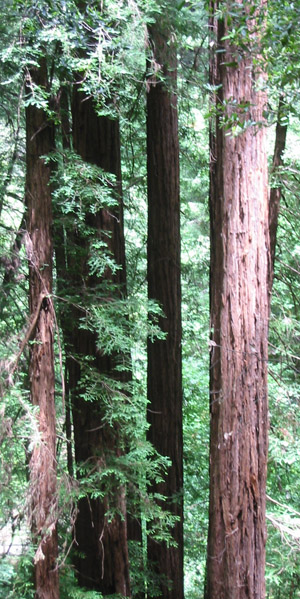 The trappings of prosperity pursued by contemporary city dwellers emphasize the appeal of "living large," hinting that the ends of financial aggrandizement will justify any means. But here in the Bay Area, we also enjoy a wealth of nearby natural resources that remind us of just how small any one person is in the grander scheme of Earth. These two sides of the spectrum meet in the old-growth redwood forest of Muir Woods, located only 15 miles north of San Francisco's financial district yet rooted in a time that predates our mercantile madness by millions of years.
The trappings of prosperity pursued by contemporary city dwellers emphasize the appeal of "living large," hinting that the ends of financial aggrandizement will justify any means. But here in the Bay Area, we also enjoy a wealth of nearby natural resources that remind us of just how small any one person is in the grander scheme of Earth. These two sides of the spectrum meet in the old-growth redwood forest of Muir Woods, located only 15 miles north of San Francisco's financial district yet rooted in a time that predates our mercantile madness by millions of years.
Here the coast redwood (Sequoia sempervirens), the tallest species of tree in the world, grows to heights of 250 feet and dwarfs the oak, bay, madrone, and douglas fir that usually dominate the canopy of northern California forests. Walking among these giants, one feels the hushed weight of history, a sense of being watched over by the elders. In fact, many of the specimens here were already reaching for the clouds when Columbus set sail -- the mature trees of Cathedral and Bohemian groves average between 600 and 800 years old, with the oldest at least 1,100 years old. But even these are young for a redwood, which can live to more than 2,200 years of age and grow over 350 feet tall.
First-time visitors to Muir Woods often crane their necks and stare upward like tourists in downtown Manhattan, spellbound at the spectacle of the skyscraping trees. But don't forget to look down -- the understory deserves its share of attention too, especially now at the beginning of the year when some of our greatest botanical treasures come into bloom.
 For example, the slinkpod or fetid adder's tongue (Scoliopus bigelovii) emerges from underground in the wet weeks of late January, a low-growing foil to the redwoods' dizzying heights. This member of the lily family features a single pair of clasped basal leaves sheathing two or three flower stems per plant, each with an unusual yellowish-green blossom mottled in stripes of purple and brown. The long, narrow petals and high tri-forked style give this flower the appearance of an orchid, while its elusive tendency accounts for the homage it receives from native plant fanciers. After the flower is pollinated, the stem will gently keel over to deposit the seed pod on the forest floor, hence the cognomen "slinkpod" and the source of the generic name (Scoliopus means "crooked foot" in Greek).
For example, the slinkpod or fetid adder's tongue (Scoliopus bigelovii) emerges from underground in the wet weeks of late January, a low-growing foil to the redwoods' dizzying heights. This member of the lily family features a single pair of clasped basal leaves sheathing two or three flower stems per plant, each with an unusual yellowish-green blossom mottled in stripes of purple and brown. The long, narrow petals and high tri-forked style give this flower the appearance of an orchid, while its elusive tendency accounts for the homage it receives from native plant fanciers. After the flower is pollinated, the stem will gently keel over to deposit the seed pod on the forest floor, hence the cognomen "slinkpod" and the source of the generic name (Scoliopus means "crooked foot" in Greek).
Also in the lily family, two species of Trillium (T. ovatum and T. chloropetalum) grace these woods every February. The former has a white blossom aging to pink, while the latter can be yellow to dark purple with a sweet rose-like or spicy scent. Arising from a rhizome, each delicate three-petalled flower is subtended by a whorl of three leaves on a single stem, like a delicate ballerina nodding over a green tutu. Difficult in the garden and demanding great patience from the commercial grower (plants grown from seed can require seven years before blooming), Trillium commands top dollar in the marketplace and stands among the most prized jewels in horticulture.
For a great groundcover in sun-challenged yards, look no further than redwood sorrel (Oxalis oregana), a clover-like perennial that grows throughout these woods and is just coming into flower. Unlike its cousin Oxalis pes-caprae, the pernicious urban weed from South Africa, redwood sorrel occurs naturally in moist conifer forests throughout northern California and the Pacific Northwest, an ecologically friendly addition to any planned landscape in the Bay Area. Here in Muir Woods, the delicate leaves and white-to-pink blossoms create a soft horizontal texture that balances the soaring vertical lines of the trees, an effect that also works well in the garden.
A single redwood may evoke gasps of historic vertigo (the oldest living specimens today were saplings before the birth of Christ), but the species itself provides even greater perspective, a glimpse back to the age of dinosaurs. In the late Jurassic period, a variety of redwood-like trees covered most of the Northern Hemisphere. Climate changes over the subsequent 140 million years slowly winnowed their ranks until now only two species remain, both confined to narrow ranges: the coast redwood in a thin and discontinuous 500-mile strip along the Pacific from southern Oregon to Monterey, and the giant sequoia (Sequoiadendron giganteum) in small groves on the western flanks of the high Sierra.
But where the vagaries of nature have acted at the glacial speed of evolution, the greed of mankind morbidly accelerated the dwindle. Old-growth redwood forests, estimated to have covered 2 million acres in the early 19th century, now have been reduced by over 97%. Loggers viewed those vast stands of timber as an infinite, inexhaustible supply, and quickly set off down the path that would prove them mistaken. The 295 acres of Muir Woods encompass the last remaining old-growth redwood forest in the Bay Area, and one of the few remaining in the world.
These ancient trees offer silent yet powerful testimony to the value of natural conservation, and today this forest bears the name of our greatest conservationist -- but John Muir actually had nothing to do with the process that spared these trees from the saw. This remote region along Redwood Creek on the southeast corner of Mt. Tam was initially passed over by the logging companies because of its inaccessibility and the steepness of the surrounding valley slopes, rendering the quick extraction of wood infeasible. The parcel was purchased in 1905 by Congressman William Kent and his wife Elizabeth Thatcher Kent, who rightly noted the implicit value of an uncut old-growth forest. They maintained their commitment to protect these trees even after the 1906 San Francisco earthquake, when the rebuilding effort created enormous demand for lumber. In 1907, the Tamalpais Land and Water Company announced its intention to dam the creek at today's park entrance and flood the valley, but the Kents thwarted this development too by donating the land to the federal government. Teddy Roosevelt declared the park a national monument the following year, and wanted to name it for William Kent, but the Congressman insisted on a more appropriate moniker. John Muir later told him, "This is the best tree-lover's monument … in all the forests of the world. You have done me great honor, and I am proud of it."
We should all take pride in Kent's heroic gesture of a century ago, and aspire to similar heights of selfless integrity. A walk among the redwoods can make a man feel very small, yes, but the simple act of saving them can increase his stature a hundredfold. Living large, indeed.
* * *
Geoffrey Coffey is planting seeds for the 43rd century. He is the founder of Madroño landscape design studio and a freelance writer for the San Francisco Chronicle.

